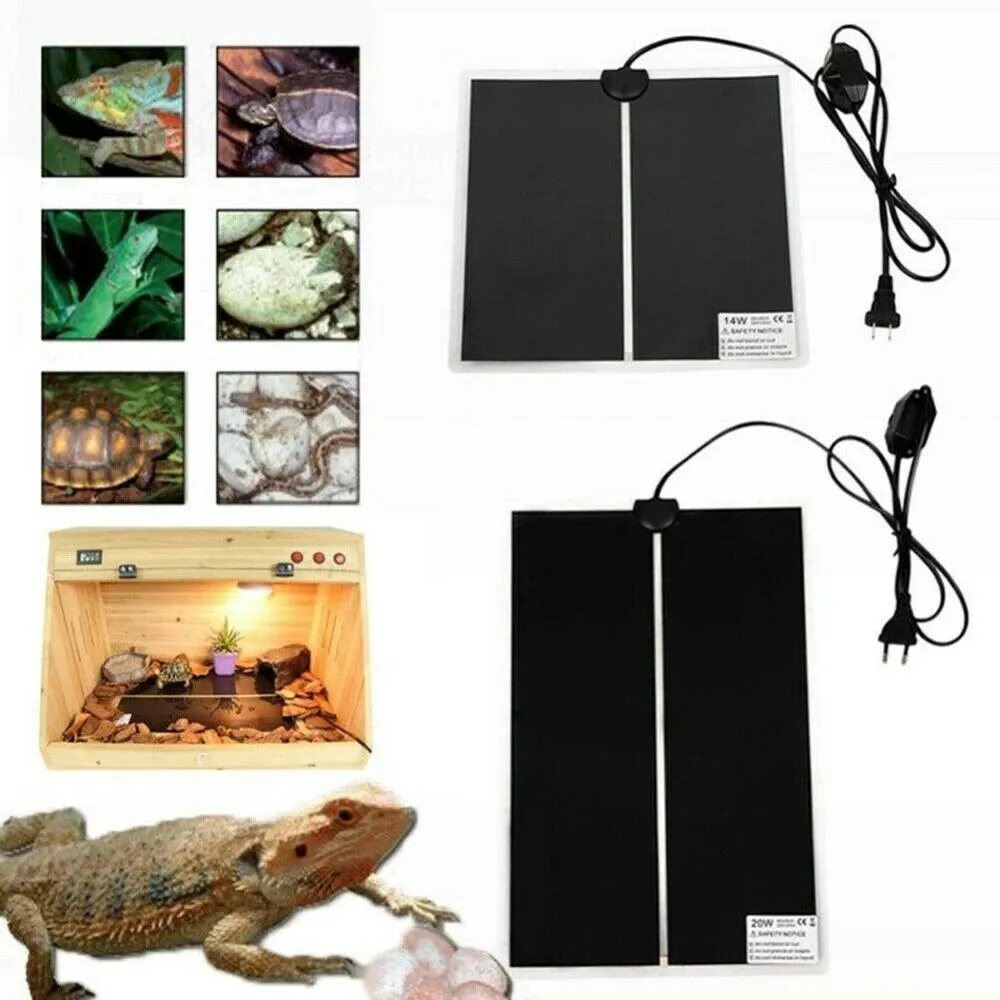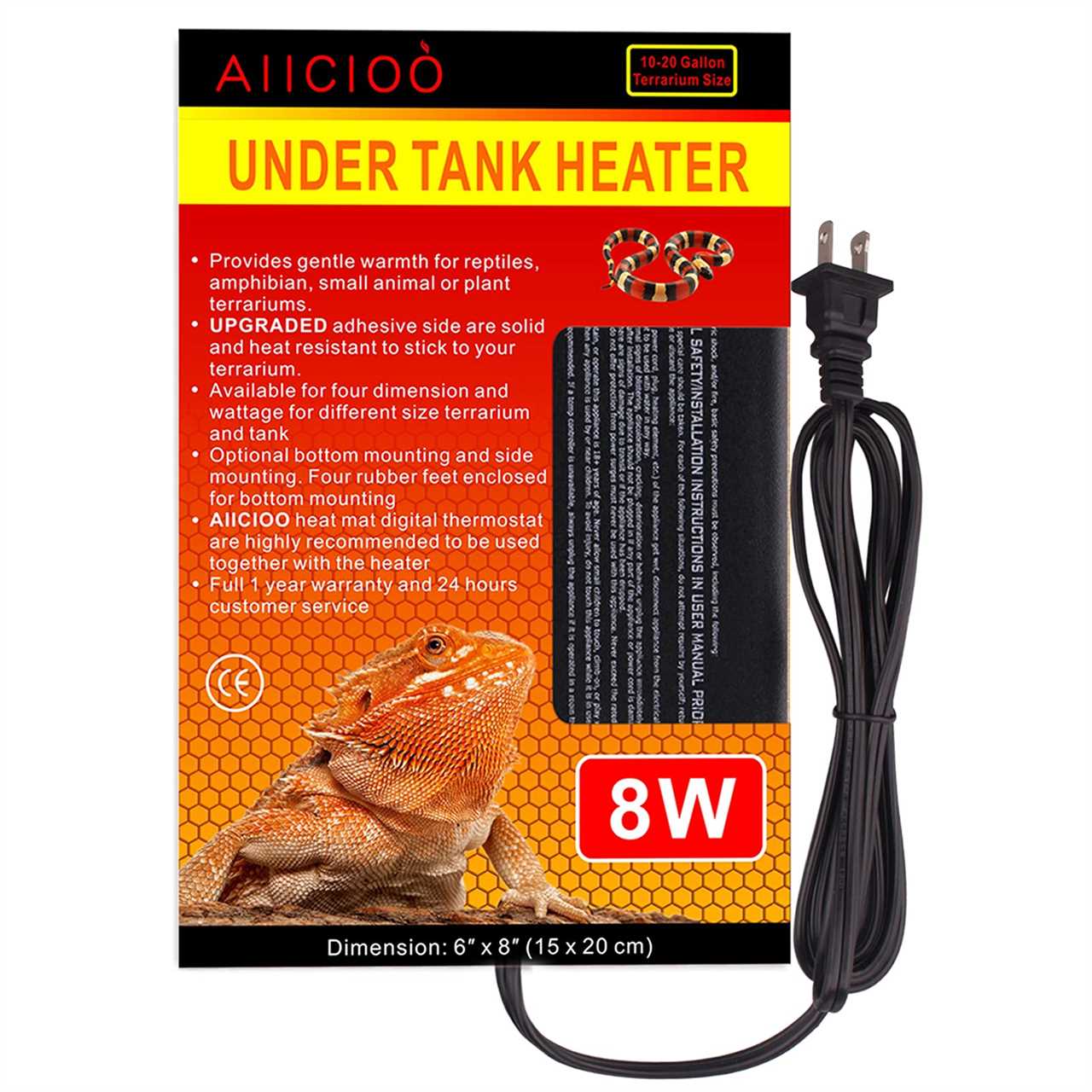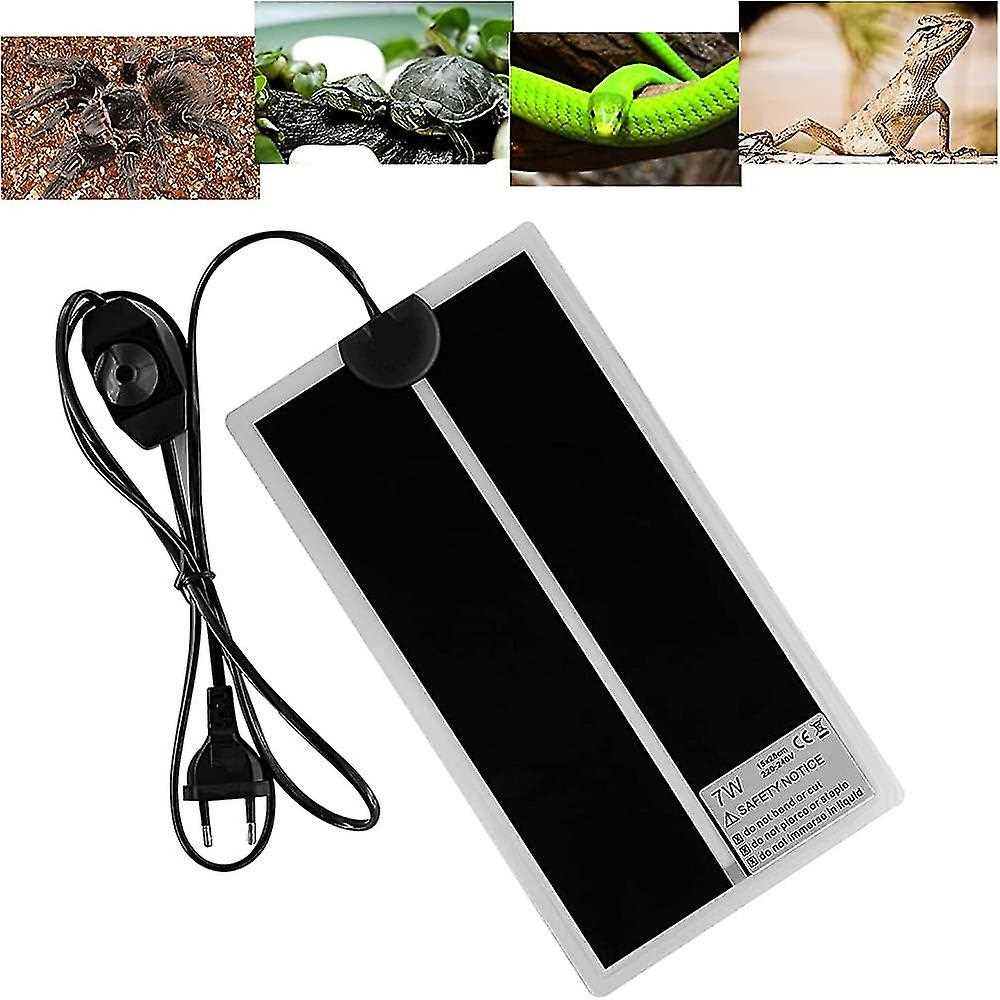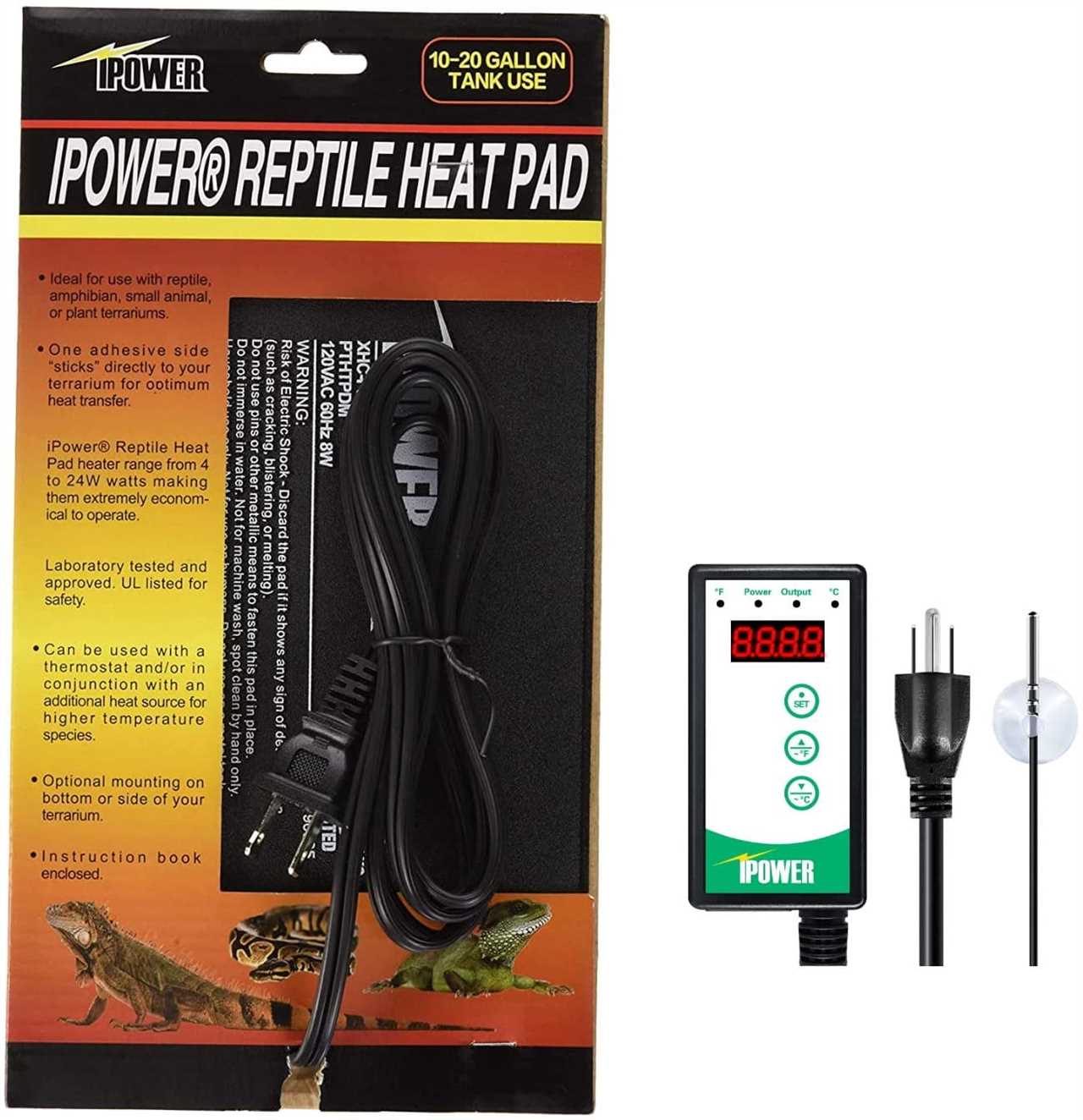
Proper temperature control is crucial for the health and well-being of your reptile. Reptiles are ectothermic creatures, meaning they rely on external heat sources to regulate their body temperature. Whether you have a snake, lizard, or turtle, providing the right amount of heat in their terrarium is essential for their survival.
There are several types of heaters available for reptiles, including heat lamps, ceramic heaters, heat mats, and radiant heat panels. Each type has its pros and cons, and choosing the best heat source for your pet depends on various factors such as species, size, and habitat.
Proper heating is crucial for the well-being and health of reptiles in captivity. Reptiles are ectothermic, which means they rely on external sources of heat to regulate their body temperature. In their natural habitat, reptiles can move to different areas to find the optimal temperature. However, in a terrarium or habitat, they rely on the temperature provided by their owner.
Ambient heat is necessary for reptiles to perform essential physiological functions such as digestion, immune system function, and overall activity level. Providing the optimal heat source is essential for reptiles to thrive in captivity and mimic their natural environment as closely as possible.
Heat lamps are a popular choice for reptile habitats. These lamps emit light and heat, providing a warm spot for the reptile to bask. The basking spot should be set at a specific temperature, depending on the species, using a thermometer to ensure accuracy. This allows the reptile to thermoregulate by moving closer or farther away from the heat source.
Heat mats

Types of Reptile Heaters
Heat Lamps
One popular type of reptile heater is the heat lamp. These lamps emit a strong and focused beam of heat, simulating the warmth of the sun. Heat lamps are commonly used for reptiles that require basking, such as lizards and turtles. They can be paired with a thermometer to monitor the temperature and ensure it stays within the recommended range for your reptile’s species.
Ceramic Heat Emitters
Radiant Heat Panels
Radiant heat panels are efficient heating solutions that provide gentle, even heat distribution. These panels are mounted on the ceiling or side of the reptile enclosure, allowing the heat to radiate downwards. Radiant heat panels are a great option for reptiles that require a constant heat source, such as snakes. However, they can be more expensive compared to other heating options.
Under Tank Heaters
Heat Pads and Mats for Reptile Enclosures
Heat pads and mats are commonly used as a heat source for reptile enclosures. They provide a safe and effective way to maintain the desired temperature in the reptile’s habitat. Heat pads and mats are particularly popular for use in terrariums and other enclosed reptile habitats.
How do Heat Pads and Mats Work?
Heat pads and mats are designed to emit a steady supply of heat to the reptile’s habitat. They are usually made of a durable and waterproof material that can withstand the reptile’s environment. The heat from the pad or mat is radiated upwards, providing a warm surface for the reptile to rest on.
Benefits of Heat Pads and Mats
Heat pads and mats offer several benefits for reptiles and their keepers:
- Localized Heat: Heat pads and mats provide a localized heat source, creating a warm basking spot for the reptile. This allows the reptile to regulate its body temperature by moving closer to or further away from the heat source as needed.
- Safe and Reliable: Heat pads and mats are designed to be safe and reliable. They are typically low voltage and have built-in safety features to prevent overheating and electrical hazards.
- Cost-Effective: Heat pads and mats are relatively inexpensive compared to other types of reptile heaters. They are also energy-efficient, consuming less electricity than heat lamps or ceramic heat emitters.
- Easy to Install: Heat pads and mats are easy to install. They usually come with adhesive backing that allows them to be securely attached to the underside of the reptile’s enclosure.
Overall, heat pads and mats are a popular and practical choice for providing heat to reptile enclosures. They offer localized heat, are safe and reliable, cost-effective, and easy to install. When used in conjunction with a thermometer and thermostat, they can help maintain the ideal temperature for your reptile’s comfort and well-being.
Heat Lamps for Reptile Terrariums

When choosing a heat lamp for your reptile terrarium, it is essential to consider the size and type of your pet’s habitat. If you have a large enclosure, you may need multiple heat lamps to ensure even heating throughout the entire space. Additionally, be sure to select a lamp that is appropriate for the size of your reptile to avoid overheating or insufficient heating.
Heat lamps are commonly used in conjunction with a heatmat or heating pad to create a gradient of temperatures within the terrarium. This allows your reptile to self-regulate its body temperature by moving between warmer and cooler areas. The combination of a heat lamp and a heatmat can provide a more natural and comfortable environment for your pet.
Benefits of Using Heat Lamps:
- Provides a focused beam of heat
- Allows for temperature adjustments
- Offers versatility in wattage and bulb type
- Creates a gradient of temperatures
- Can be used in combination with heatmats for optimal heating
Ceramic Heat Emitters for Reptiles
One of the main advantages of ceramic heat emitters is that they do not emit light, making them ideal for reptiles that are sensitive to bright lights, such as nocturnal species. This allows reptiles to maintain their natural day and night cycles without disturbance.
Ceramic heat emitters are also known for their ability to produce a constant and consistent heat output. They are designed to reach high temperatures, making them suitable for creating basking spots within the terrarium. This is especially important for reptiles that require a specific temperature gradient in their habitat.
In addition to providing heat, ceramic heat emitters can also be used to create localized hot spots in the terrarium. By positioning the emitter in a specific area, reptile owners can create a basking spot for their pet reptile to regulate their body temperature.
Another benefit of ceramic heat emitters is that they are durable and long-lasting. Unlike other types of heaters, ceramic heat emitters do not have a filament that can burn out, making them a cost-effective option for reptile owners.
Radiant Heat Panels: Efficient Heating Solutions for Reptile Terrariums

What are Radiant Heat Panels?
Radiant heat panels are a type of reptile heater that provide heat to your pet’s terrarium or enclosure. Unlike heat lamps or heat mats, radiant heat panels emit infrared radiation, which simulates the natural sun and creates a gentle and consistent heat source. These panels are typically mounted on the ceiling or the side of the terrarium, providing heat that radiates downwards and warms the entire habitat.
Benefits of Radiant Heat Panels
2. Wide Coverage: These panels can heat a larger area compared to heat lamps or heat mats, ensuring that your reptile has enough warm spaces to thermoregulate.
3. Safe for Reptiles: Unlike heat lamps, radiant heat panels do not emit visible light, reducing stress for nocturnal reptiles. They also have a low surface temperature, minimizing the risk of burns.
4. Even Heat Distribution: Radiant heat panels provide a more uniform heat distribution throughout the terrarium, creating a comfortable environment for your reptile.
Installation and Usage
When using a radiant heat panel, it is recommended to use a thermostat to regulate the temperature. This ensures that the heat output remains consistent, avoiding any fluctuations that could be harmful to your reptile. It is also essential to provide a temperature gradient within the terrarium, allowing your reptile to move to warmer or cooler areas as needed.
Considerations for Reptile Owners
Before purchasing a radiant heat panel, consider the size and specific needs of your reptile. Different species require different temperature ranges, so it is crucial to research your pet’s ideal temperature requirements.
Additionally, ensure that the radiant heat panel you choose is the appropriate size for your terrarium. A panel that is too small may not provide enough heat, while a panel that is too large may create excessive heat and discomfort for your reptile.
Under Tank Heaters for Bottom Heat
Under tank heaters are typically attached to the bottom of the tank using adhesive, making them easy to install. They come in various sizes to accommodate different tank sizes and can be controlled using a thermostat to maintain the desired temperature.
Overall, under tank heaters offer a convenient and effective way to provide bottom heat for reptiles. They help to create a natural and comfortable habitat for reptiles while allowing for easy temperature control. When used in conjunction with other heat sources, under tank heaters can help create the optimal temperature gradient for reptiles to thrive in their terrariums.
Thermostats: Temperature Control for Reptile Heaters
Why Do You Need a Thermostat?
A thermostat is a device that allows you to control the temperature inside your reptile terrarium. It is an essential tool for maintaining the optimal temperature range that your reptile requires. Without a thermostat, it can be challenging to regulate the heat in the enclosure, which can lead to temperature fluctuations that can be harmful to your pet.
By using a thermostat, you can ensure that the heat from the reptile heater is maintained at a consistent temperature. This is particularly important for reptiles that require specific temperature gradients within their habitat. A thermostat will allow you to set the desired temperature and make adjustments as needed.
Choosing the Right Thermostat
There are several types of thermostats available on the market, so it’s essential to choose one that suits your needs. One popular option is a proportional thermostat, which uses advanced technology to maintain a constant temperature. These thermostats are highly accurate and can effectively regulate the heat output of your reptile heater.
Another common type of thermostat is an on/off thermostat. This type of thermostat operates by turning the heater on or off to maintain the desired temperature range. While less precise than proportional thermostats, they are still an effective way to control the temperature in your reptile enclosure.
How to Use a Thermostat
Using a thermostat is relatively straightforward. First, you will need to install the thermostat in your reptile habitat, typically near the heat source. Make sure to follow the manufacturer’s instructions and ensure that the sensor is correctly positioned to accurately measure the temperature.
Next, set the desired temperature range on the thermostat. This will vary depending on the specific needs of your reptile species. It’s crucial to research the ideal temperature range and create the necessary heat gradients within the enclosure.
Monitor the temperature in the habitat regularly using a reliable thermometer. This will allow you to ensure that the thermostat is functioning correctly and that the temperature is within the desired range. Make adjustments to the thermostat as needed to maintain a consistent and optimal temperature for your reptile.

I’m Lena Adams—a product of an unconventional upbringing in the African wilderness. My father, a daring explorer of African wildlife, sparked my fascination with reptiles, a passion that intertwined with the tragic loss of my mother during an expedition, leaving an indelible mark on my life. Driven to understand the creatures that captivated my parents, I embarked on my journey, sharing insights about reptiles, frogs, and lizards on my website. Through my explorations and conservation efforts, I honour my family’s legacy while seeking connections—to the creatures, nature, and the mother whose presence I yearn to understand.
